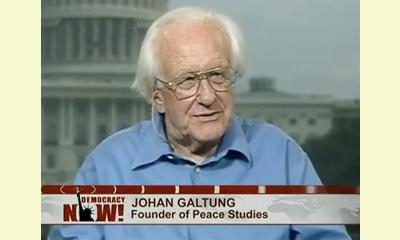|
|
And Yet, It Moves! – The Case of Education for Peace in Mexico
an article by Johan Galtung & Fernando Montiel – TRANSCEND Media Service
The indigenous rising in Chiapas, 1994 changed
Mexico in several different ways. On the one hand
it placed hidden historical –and yet massive and
painful- topics just in the middle of the
political debate: racism and indigenous rights
among others came out of the closet to be
discussed, addressed and -hopefully- solved.

click on photo to enlarge
Hard politics entered the scene after the romantic
episode of the Zapatista rebellion -characterized
by the masked men and women and their tale-writer
and political leader- by means of counter
insurgency policies, paramilitary groups and
propaganda campaigns, among others. And it was
exactly then, when more concern and attention and
clarity and coverage was needed from the
international community, that the eyes of the
world started turning to some other crises
elsewhere. The massacre of 45 woman and children
in Acteal (Dec. 22, 1997) briefly placed Chiapas
again in the headlines but after the atrocity
silence ruled again.
Those past events in the 90s seeded and nurtured
much of the cataclysm that would come later, which
in recent past became known as the “war on drugs.”
For these reasons it is quite surprising that
specialists fail to make the connection between
one crisis and the other notwithstanding the
common ground. The special forces used now to
fight drug dealers/producers were formed because
of the 1994 uprising; the militarization –now
rampant and nationwide- began with Chiapas; the
abandon of the countryside –one of the Zapatista
complaints- is fertile soil for drug trafficking
and NAFTA –North American Free Trade Agreement-
which was enacted the exact same day the rebellion
started with three effects:
1) it destroyed the little farmers –who now had to
compete with the heavily subsidized U.S. agro
industry,
2) it flooded Mexico with legal corporations –but
not jobs- and illegal money, which in turn
3) flooded the US with drugs and Mexicans who were
expelled from the countryside and for whom their
country has nothing to offer but corruption.
That is a brief rough draft of the tragedy.
And now? Well, after six years of the “war on
drugs” (which in fact is 42 years old; it started
in 1971 under Pres. Nixon; six years is the
Mexican government ‘official’ count) just add a
hundred thousand people killed, thirty thousand
disappeared, millions traumatized, the fact that
one out of four Mexicans live in the US as
economic refugee, that six out of ten live in
poverty, and that ten million of them –out of a
population of 120 million- live in misery, and we
will have an updated image of the situation.
Hopeless? No. Certainly not.
Massive structural violence as the one depicted
above can only be addressed with massive peace
policies; and in Mexico, much of them are on their
way -both in national and regional levels- but
even better, some of them are already here,
working, acting and yielding good results.
(This article is continued in the discussionboard)
|








|
DISCUSSION
There is no question yet associated with this article.
* * * * *
Latest reader comment:
(The following is continued from the main article listed above.)
At the national level an overarching program to prevent violence has been designed and enacted. Despite the fact that it misses some important topics –such as peace journalism, peace museums, peace business and nonviolent communication- it is a bold proposal, grounded in a legitimate peace philosophy –one in which peace is constructed through the satisfaction of basic human needs- and is well equipped in scope and with enough budget and personnel to achieve transcending results by construction of peace infrastructures (i.e. mediation centers, academic degrees in peace for civil servants, etc.) and the buildup of a mediation-dialogue-conciliation culture that had been floating in the air for some years but is now becoming a very concrete way of life not only in scholarly circles but also in civil society and government.
This top-down approach is then linked with efforts bottom-up from the ground level in the different regions. In the same way the State of Puebla was a pioneer in boosting mediation in legal practice; the State of Mexico –a region of the country- is a formidable example of how peace education can be better served by summing up efforts in all directions from NGOs to government to individual commitments. Under the overarching umbrella of a project called Programa para una Convivencia Escolar Armónica (Program for a Harmonious Coexistence in School) thousands of school teachers, parents and tens of thousands of students are getting acquainted not only with strategies on how to deal with bullying but also on a wide range of conflict transformation techniques for everyday conflicts in all domestic contexts.
TRANSCEND is an active partner in all of the above–and more. Supporting the development of legal mediation throughout the country along with the Supreme Court, enhancing the possibilities for the constitution of a National Commission of Peace –now well advanced at State level with State Commissions already active and supported by up to 300 NGOs now contributing with trainers instruction, documenting experiences, designing proposals, certifying competences and providing study material for dissemination and articulation of peace education.
This is taking place right now; and next year –already around the corner- a giant leap could take place: the creation of the first Peace Study Center associated with the public administration.
Certainly not enough, but not bad either.

|
|








